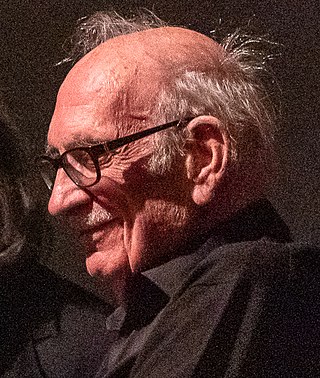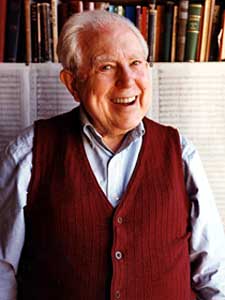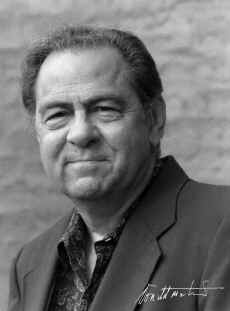This article has multiple issues. Please help improve it or discuss these issues on the talk page . (Learn how and when to remove these template messages)
|
Paul Lansky (born June 18, 1944, in New York) is an American composer.
This article has multiple issues. Please help improve it or discuss these issues on the talk page . (Learn how and when to remove these template messages)
|
Paul Lansky (born June 18, 1944, in New York) is an American composer.
Paul Lansky (born 1944) is an American composer. He was educated at Manhattan's High School of Music and Art, Queens College and Princeton University, studying with George Perle and Milton Babbitt, among others. He received his Ph.D. in music from Princeton in 1973. His doctoral dissertation consisted of an essay titled "Affine music" and a composition of string quartet. [1] [2] Originally intending to pursue a career in performance, during 1965–66 he played the French horn with the Dorian Wind Quintet. He left the group to attend graduate school. From 1969 until his retirement in 2014 he was on the faculty at Princeton University where he retired as the William Shubael Conant Professor of Music. He chaired the Department from 1991–2000. In 2000 he received a lifetime achievement award from the Society for Electro-Acoustic Music in the United States. In 2009–10 he was the inaugural composer in residence with the Alabama Symphony. In 2016 he was elected to the American Academy of Arts and Letters. He has received grants and awards from the Guggenheim Foundation, the Fromm Foundation and the Koussevitsky Foundation, the National Endowment for the Arts and Chamber Music America, among others.
Beginning in the mid 1960s Lansky was among the first to experiment with the computer for sound synthesis. Until 2004 this was his predominant focus. Since then he has concentrated on instrumental composition without any electronic involvement.[ citation needed ]
Sounds originating from "real-world" sources are the predominant focus of Lansky's computer music: traffic, kids in the kitchen, musical instruments, and most of all speech. Electronic synthesis is frequently used but the main sonic resources are transformations of recorded natural sounds. One of his first large pieces, Six Fantasies on a Poem by Thomas Campion (1979) set the stage. It is based on a reading by his wife Hannah MacKay of a famous poem. The piece is not so much a setting of the poem as it is a study of the contours of a live reading of the poem. The work uses a technique known as linear predictive coding, LPC, which was developed in the 1960s by scientists as a data-reduction technique meant to economize on the amount of data needed for digital voice transmission and is used today in some cell phone communication. It allows for the separation of pitch and speed and the pitch contours of the speech can be altered independently of the speed. Each of the six movements explores a different aspect of speech. This led to a series of "chatter" pieces, Idle Chatter, etc. that fragment the speech into a percussive rap-like texture. Other projects included folksong settings (Folk Images), a portrait of a woman (Things She Carried), a contemplation of letters and numbers (Alphabet Book), sounds of the highway (Night Traffic, Ride), blues harmonica, electric guitar, piano improvisation and casual conversation. The bulk of his approximately 70 electronic compositions are contained on ten solo CDs (see Discography). While there are a few pieces for electronics and live instruments the bulk of Lansky's pieces are recorded "tape" pieces.
Lansky's works have attracted interest in various realms. They have been used by dance companies (Bill T. Jones, Eliot Feld Ballet, New York City Ballet). His works frequently have a rhythmic "groove" that is attractive to dancers. In 2000 he was the co-subject (along with Francis Dhomont) of a documentary film made for the European Arte network by Uli Aumüller, My Cinema for the Ears that deals with the use of natural sounds. A four-chord sequence from Lansky's first large computer piece Mild und leise (1972) was sampled by the English rock band Radiohead for the track "Idioteque" on their 2000 Kid A album.
Lansky used any available computing hardware: IBM mainframes at first (1966–84), then mini and micro computers by DEC, (1984–89), and finally personal computers by NeXT, Silicon Graphics and Apple Computer. During the mainframe era computer time was scarce and expensive, and this prompted Lansky to write his own software package called Mix, in Fortran. This made it easier to assemble a composition voice-by-voice, section-by-section, even note-by-note, avoiding large expensive runs to create an entire piece at once. Mix had no scheduler (meaning that it could create notes in any order) and thus was not suitable for real-time synthesis. Mix used additive writes to the output device, analogous to overdubbing on tape. When the move was made to minis and micros, Lansky ported Mix to the C programming language and called it CMix. During the late 1990s a group led by Brad Garton at Columbia University created a version with a scheduler, RtCmix, that was capable of real time synthesis. Starting in the mid 1990s Lansky used a well-known software package called SuperCollider. Programs like Cmix and SuperCollider are script-based rather than driven by a graphical interface. (Input data is frequently in the form of a program rather than a note list.) This facilitated the creation of complex textures in works such as Idle Chatter, which contain thousands of short notes, frequently selected using random methods. This is sometimes called algorithmic composition.
During the mid 1990s Lansky began to be approached by performers who were attracted to the performative-like aspects of his computer music. Percussionists in particular were attracted by pieces such as Table’s Clear, which resembles a gamelan made of pots and pans, and the "chatter" series. One of his first large percussion pieces was Threads, 2005, written for the Sō Percussion quartet. Since then there are about a dozen pieces for percussion instruments, alone and in various ensembles. Another focus has been classical guitar, alone and in combination: Semi-Suite, With the Grain (concerto), Partita (guitar and percussion.) A residency with the Alabama Symphony led to several orchestral pieces (Shapeshifters, Imaginary Islands). Significant commissions came from the Library of Congress and the Chamber Music Society of Lincoln Center for the wind quintet The Long and Short of It, and Chamber Music America for a trio for the Janus Trio, Book of Memory, and for Sō Percussion, Springs. The 2004 trio for horn, violin and piano, Etudes and Parodies won the 2005 International Horn Society prize. Lansky's instrumental music is published by Carl Fischer. The bulk of his computer music as well as much instrumental music is available on Bridge Records.
Most of Lansky's works are basically tonal. In general terms this means the apparent background source for his pitch language is the diatonic scale rather than the chromatic or microtonal scale. He frequently uses traditional tonal syntax. During 1969–72 he collaborated with George Perle on an expansion of Perle's 12-tone tonality, which led to Perle's book of the same name. This approach basically establishes another metric for measuring and relating harmonies that has to do with symmetry. It is related to some music by Bartok. Some of Lansky's work such as Notes to Self, for piano, and It All Adds Up, for two pianos, use this approach. Lansky's instrumental music generally eschews extended instrumental techniques. He writes that he scratched that itch with computer music.[ citation needed ]
A long-term interest of Lansky's is music "about" music. Earlier examples of this are his computer pieces Guy's Harp, about blues harmonica, and Not So Heavy Metal, about rock and roll guitar. More recent examples are Book of Memory, which comments on music from Machaut to Scriabin, Ancient Echoes, based on late-16th-century dance music, and Ricercare Plus, inspired by 17th-century counterpoint.

Atonality in its broadest sense is music that lacks a tonal center, or key. Atonality, in this sense, usually describes compositions written from about the early 20th-century to the present day, where a hierarchy of harmonies focusing on a single, central triad is not used, and the notes of the chromatic scale function independently of one another. More narrowly, the term atonality describes music that does not conform to the system of tonal hierarchies that characterized European classical music between the seventeenth and nineteenth centuries. "The repertory of atonal music is characterized by the occurrence of pitches in novel combinations, as well as by the occurrence of familiar pitch combinations in unfamiliar environments".

George Henry Crumb Jr. was an American composer of avant-garde contemporary classical music. Early in his life he rejected the widespread modernist usage of serialism, developing a highly personal musical language which "range[s] in mood from peaceful to nightmarish". Crumb's compositions are known for pushing the limits of technical prowess by way of frequent use of extended techniques. The unusual timbres he employs evoke a surrealist atmosphere which portray emotions of considerable intensity with vast and sometimes haunting soundscapes. His few large-scale works include Echoes of Time and the River (1967), which won the 1968 Pulitzer Prize for Music, and Star-Child (1977), which won the 2001 Grammy Award for Best Contemporary Classical Composition; however, his output consists of mostly music for chamber ensembles or solo instrumentalists. Among his best known compositions are Black Angels (1970), a striking commentary on the Vietnam War for electric string quartet; Ancient Voices of Children (1970) for a mixed chamber ensemble; and Vox Balaenae (1971), a musical evocation of the humpback whale, for electric flute, electric cello, and amplified piano.

Elliott Cook Carter Jr. was an American modernist composer. One of the most respected composers of the second half of the 20th century, he combined elements of European modernism and American "ultra-modernism" into a distinctive style with a personal harmonic and rhythmic language, after an early neoclassical phase. His compositions are performed throughout the world, and include orchestral, chamber music, solo instrumental, and vocal works. The recipient of many awards, Carter was twice awarded the Pulitzer Prize.

James Tenney was an American composer and music theorist. He made significant early musical contributions to plunderphonics, sound synthesis, algorithmic composition, process music, spectral music, microtonal music, and tuning systems including extended just intonation. His theoretical writings variously concern musical form, texture, timbre, consonance and dissonance, and harmonic perception.
Brad Garton is an American composer and computer musician who is professor of music at Columbia University.

Roger Lee Reynolds is a Pulitzer prize-winning American composer. He is known for his capacity to integrate diverse ideas and resources, and for the seamless blending of traditional musical sounds with those newly enabled by technology. Beyond composition, his contributions to musical life include mentorship, algorithmic design, engagement with psychoacoustics, writing books and articles, and festival organization.
Real-Time Cmix (RTcmix) is one of the MUSIC-N family of computer music programming languages. RTcmix is descended from the MIX program developed by Paul Lansky at Princeton University in 1978 to perform algorithmic composition using digital audio soundfiles on an IBM 3031 mainframe computer. After synthesis functions were added, the program was renamed Cmix in the 1980s. Real-time capability was added by Brad Garton and David Topper in the mid-1990s, with support for TCP socket connectivity, interactive control of the scheduler, and object-oriented embedding of the synthesis engine into fully featured applications.
MUSIC-N refers to a family of computer music programs and programming languages descended from or influenced by MUSIC, a program written by Max Mathews in 1957 at Bell Labs. MUSIC was the first computer program for generating digital audio waveforms through direct synthesis. It was one of the first programs for making music on a digital computer, and was certainly the first program to gain wide acceptance in the music research community as viable for that task. The world's first computer-controlled music was generated in Australia by programmer Geoff Hill on the CSIRAC computer which was designed and built by Trevor Pearcey and Maston Beard. However, CSIRAC produced sound by sending raw pulses to the speaker, it did not produce standard digital audio with PCM samples, like the MUSIC-series of programs.

Max Vernon Mathews was an American pioneer of computer music.
The Computer Music Center (CMC) at Columbia University is the oldest center for electronic and computer music research in the United States. It was founded in the 1950s as the Columbia-Princeton Electronic Music Center.
Alfred Whitford (Fred) Lerdahl is the Fritz Reiner Professor Emeritus of Musical Composition at Columbia University, and a composer and music theorist best known for his work on musical grammar and cognition, rhythmic theory, pitch space, and cognitive constraints on compositional systems. He has written many orchestral and chamber works, three of which were finalists for the Pulitzer Prize for Music: Time after Time in 2001, String Quartet No. 3 in 2010, and Arches in 2011.

George Perle was an American composer and music theorist. As a composer, his music was largely atonal, using methods similar to the twelve-tone technique of the Second Viennese School. This serialist style, and atonality in general, was the subject of much of his theoretical writings. His 1962 book, Serial Composition and Atonality: An Introduction to the Music of Schoenberg, Berg, and Webern remains a standard text for 20th-century classical music theory. Among Perle's awards was the 1986 Pulitzer Prize for Music for his Wind Quintet No. 4.
Raul Alejandro Viñao is an Argentine composer based in London.
Mario Davidovsky was an Argentine-American composer. Born in Argentina, he emigrated in 1960 to the United States, where he lived for the remainder of his life. He is best known for his series of compositions called Synchronisms, which in live performance incorporate both acoustic instruments and electroacoustic sounds played from a tape.

François-Bernard Mâche is a French composer of contemporary music.
Junya Nakano is a Japanese video game composer. After working for Konami in the early 1990s, he was employed by Squaresoft and then Square Enix from 1995 to 2009. He is best known for scoring Threads of Fate and co-composing Final Fantasy X for Squaresoft, arranging for Dawn of Mana and the Nintendo DS version of Final Fantasy IV for Square Enix, and scoring arcade video games such as X-Men and Mystic Warriors for Konami. Nakano has collaborated with Masashi Hamauzu on a number of games.

Donald James Martino was a Pulitzer Prize winning American composer.
Wayne Peterson was an American composer, pianist, and educator. He won the Pulitzer Prize for Music for The Face of the Night, the Heart of the Dark in 1992, when its board overturned the jury's unanimous selection of Concerto Fantastique by Ralph Shapey.

Sō Percussion is an American percussion quartet formed in 1999 and based in New York City.
David Aaron Jaffe is an American composer who has written over ninety works for orchestra, chorus, chamber ensembles, and electronics. He is best known for his use of technology as an electronic-music or computer-music composer in works such as Silicon Valley Breakdown, though his non-electronic music has also been widely performed. He is also known for his development of computer music algorithmic innovations, such as the physical modeling of plucked and bowed strings, as well as for his development of music software such as the NeXT Music Kit and the Universal Audio UAD-2/Apollo/LUNA Recording System.